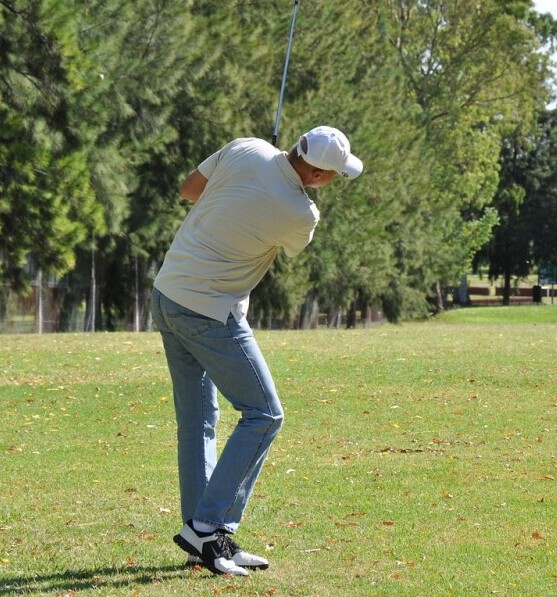What Is A Golf Bogey?


A golf bogey is one of those terms you hear tossed around a lot on the course. Basically, a bogey means completing a hole one stroke over par. If par for the hole is four, you’d have a bogey if it takes you five strokes to get that little ball into the cup. This is the golf viking, and today we’re diving deep into bogey.
The term ‘bogey’ has an interesting backstory. It actually comes from a British slang term for an imaginary person or golfer, “Colonel Bogey.” This mythical guy supposedly represented the perfect round, although today it symbolizes a less-than-perfect play. Bogey isn’t ideal for a good scorecard.
While the term is often mentioned alongside par, birdie, or eagle, each of these represents a different accomplishment in golf scoring. A bogey is generally seen as below par performance, literally and figuratively. You’re aiming to do better but sometimes, a bogey is what you walk away with, especially on those tricky holes. Bogeys happen to all of us.
The score you need for a bogey can vary depending on the course and the hole layout. Some holes are tough nuts to crack, making a bogey a decent effort. But let’s be real—consistently bagging bogeys can mean trouble for your scorecard, putting you on the wrong side of a leaderboard. So how does bogey impact your score?
To understand a bogey, it’s helpful to compare it with other golf scoring terms like what is a par in golf?
Ready to level up your golf game? Click here.

Understanding Golf Scoring and the Role of a Bogey
Golf scoring might seem a bit daunting at first if you aren’t familiar with golf, but it’s pretty straightforward once you get the hang of it. The basic idea is to complete the course using the fewest strokes possible. Each hole has a ‘par’—the expected number of strokes it should take a good golfer to sink the ball into the hole. Scoring even with par is great, going under par is what dreams are made of, and going over par leads to scores like bogeys, double bogeys, and beyond.
In the grand scheme of things, bogeys can really make or break your game. Each one adds an extra stroke to your total score, which can pile up quickly if you aren’t careful. Imagine ending up with a bag full of bogeys—it’s like adding extra hits to your playlist, but they’re all the kind you could do without.
Amateur golfers often experience more bogeys as they hone their skills, but it’s a completely different ball game for the pros. These players try their hardest to avoid bogeys because just a few can bump them down the rankings. So don’t get discouraged if you are just starting out. Trust me, you will get lots of bogeys at first. But when you are a regular or professional golfer, getting par or under par is going to be expected, and bogeys become much more critical when playing competitively.
Bogeys usually creep up in various scenarios—perhaps a tee shot veers off course or an unexpected gust of wind plays spoiler to a perfect putt. Knowing how bogeys sneak in can help formulate a game plan to keep them at bay.
While a birdie is a reason to fist-bump your caddie, bogeys remind you there’s room for improvement. And hey, who doesn’t have off days? Golf is as much about personal bests as it is about managing those off moments the best way you can. But if you want to be a serious golfer that competes against other serious golfers, you will need to cut back on the bogeys if you want to rank well.
Golfers aiming to go lower than a bogey should read about what is a birdie in golf?

Why Avoiding Bogeys is Crucial in Competitive Play
In competitive golf, avoiding bogeys can be a game-changer. These pesky extra strokes can drop you down the leaderboard faster than you’d think. For pros, every bogey is a step back in the high stakes game of rankings and titles. In a sport like golf where competition is so tight, every stroke on the course count. So even scoring just a few bogeys can completely deflate your round and put you towards the bottom of the rankings.
Bogeys don’t just affect your score; they can mess with your head. It’s easy to lose focus after a bogey, letting it knock your confidence for a loop. But remember, it’s all about getting back on track and leaving that bogey in the rearview. In a mental game such as golf, losing confidence can make you compound mistakes and spiral downward. So keeping par or less will help you keep confidence as you play through the round.
Knowing when a bogey is acceptable and when it’s a disaster comes down to strategy. Sometimes, taking a bogey to avoid bigger mistakes is wise. Giving yourself a better putt is a more sensible choice than risking getting yourself into more trouble. But most of the time, the aim is to turn that bogey potential into at least a par or better.
Professionals have developed strategies to dodge bogeys like they’re playing dodgeball. It’s about planning every shot, knowing the course inside out, and understanding your own strengths and weaknesses. Having backup plans for tricky holes can mean the difference between a bogey and a par.
Take cues from PGA Tour players who’ve mastered the art of minimizing bogeys. Their training focuses on precision and mental toughness, showing us that staying calm and collected goes a long way in keeping those bogeys at bay. So how do we keep those bogeys to a minimum?
At the extreme high end of scoring feats, you can learn about what is an albatross in golf?

Strategies to Minimize Bogeys on the Golf Course
Consistency in your shots can really lower the bogey count. Practicing regularly, especially on your weaker holes, builds up shot reliability. It’s all about knowing your swing and trusting it. More consistent shots will help keep you from those awful lies.
Analyzing the course layout can help spot potential trouble spots. If you know where the hazards lie, you can plan your shots to avoid them, keeping bogeys off your radar. Staying out of trouble can help lead to a lower score on the round. Watch those pesky bunkers, and never let your ball end up in the drink. Hitting your ball into the water or out of bounds is the surest way to land a bogey(or worse).
Sometimes what holds you back is in your head. Mental strategies, like staying in the moment and not overthinking after a bad shot, are key to maintaining focus and avoiding unnecessary bogeys. Don’t add even more strokes to your hole by getting frustrated. Just make the best shot, and try to make up for it on the next hole. Luckily there are 18, so getting a bogey in one or two doesn’t doom you.
The right gear can make a world of difference. Clubs that suit your play style can help make shots more predictable, reducing the odds of veering off course. The more familiar you get with your clubs, the more comfortable you will feel hitting them.
Listen to success stories from golfers who’ve tamed bogey-heavy rounds. Tips from others who’ve been there can give you fresh perspectives and strategies you hadn’t considered. Bogeys aren’t fun, but even the best golfers will bogey, it’s all part of the game.
More than just scoring, minimizing bogeys is about improving your whole approach. It’s the process of getting better shot by shot, game by game. Before you know it, you’re consistently breaking personal bests and enjoying the game more.
Golf’s a journey, and bogeys are just part of the wilderness you trek through. If you are new to the game of golf, you will get plenty of bogeys and worse. Don’t let that discourage you. Enjoy the challenge that golf presents and focus on improvement rather than simply score. With every round, and every shot, there’s opportunity to learn and grow into a golfer who turns challenges into triumphs. I’ll see you out on the golf course, shooting for par, of course.
If your bogeys are coming from missed greens, sharpen your skills with short game mastery.


